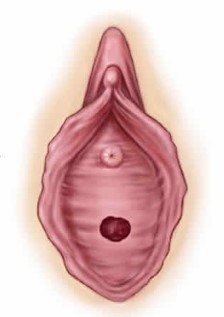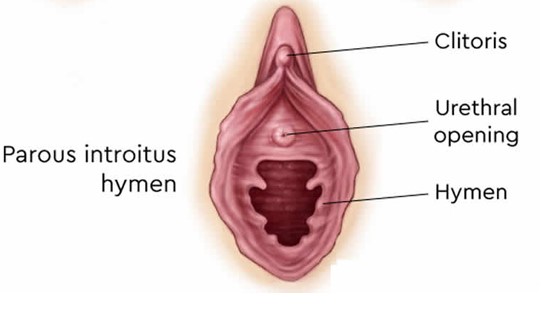Hymen Surgery
Hymenorrhaphy or hymen reconstruction surgery is the temporary surgical restoration of the hymen. It is also known as hymenoplasty, although strictly this term would also include hymenotomy.
Hymen
The hymen is a thin membrane that partially covers the entrance to the vagina. During puberty, oestrogen causes the hymen to change in appearance and become very elastic. Normal variations of the post-pubertal hymen range from thin and stretchy to thick and somewhat rigid. A non-intact or stretchedIt has relatively few blood vessels that are unlikely to cause significant bleeding.
Hymenoplasty
Hymenoplasty (also known as hymenorrhaphy or hymen reconstruction or hymen repair) is a surgical intervention that involves reconstructing the hymen. There are a number of different techniques to achieve this but generally it involves stitching the torn edges of the hymen together with dissolvable stitches. The aim of the procedure is to ensure that the women bleeds when she next has sexual intercourse.
Like any surgery, hymenoplasty carries risks but patients should be able to return to normal activities within 24 to 48 hours. Complete healing takes up to 3 months.


WHEN SHOULD ONE SCHEDULE A HYMENORRHAPHY?
The timing of the anticipated coitus may play a role in selecting your schedule. If a patient desires structural integrity and needs the hymen to be intact on visual inspection, the repair must be done 3 months before. If the timing of coitus is known and the patient desires bleeding, but visual integrity is not necessary, the surgery can be done 3 weeks before the date.
AT WHICH POINT CAN A HYMENORRHAPHY BE DONE?
The procedure can be done months or years after a woman loses her virginity.
WHAT IS THE HYMENORRHAPHY PROCEDURE LIKE?
The choice of procedure is decided by the surgeon based on the patient’s desired outcome. The common techniques include the flap, surgical adhesion, luminal reduction, and suture-only technique. The surgeon will discuss these in detail during your consultation.
Generally, all these techniques will make it possible for hymenorrhaphy to be a day procedure. It can be under local anaesthesia with sedation. Some prefer general anaesthesia to allay their anxiety during the procedure.
HOW LONG WILL THE PROCEDURE TAKE?
The process takes one to two hours, and the patient can return to work the next day.
WHAT ARE THE RISKS INVOLVED?
A hymenorrhaphy, like any other surgery, carries the risk of infection, as well as the risk of dehiscence and repair failure. But, this can be avoided with a well-trained surgeon and with proper aftercare. The small dissolvable suture may cause mild bleeding from the surgical wound, possibly with walking and other activities.
Stricture is also a potential risk which occurs with overcorrection. The membrane, which used to be elastic, becomes too tight resulting in the vaginal opening becoming too narrow. This may cause pain during sexual intercourse, but it will resolve without the need for any treatment.
If there are any adverse reactions, it will be temporary. For example, discomfort in the private parts and swelling in the outer structures of the vagina. These usually subside within days.
WHAT IS THE RECOVERY LIKE AFTER HYMENORRHAPHY?
Recovery varies for each patient. You can expect mild discomfort after the surgery, but it can be managed with an oral pain medication. After the procedure, you will be monitored for 1-2 hours in a recovery room. When you are conscious with no abnormal bleeding, you will be allowed to urinate by yourself. The surgeon will then review the post-operative care instructions with you.
You may notice light reddish bleeding from the vagina for 1-2 weeks after hymenorrhaphy. A sanitary napkin must be used to track the bleeding. Report to your doctor if you notice excessive bleeding, blood clots, swelling in the surgical site, or high fever. This could be a sign of infection.
Within the first two weeks after the hymenorrhaphy, tissues begin to produce. They will now form new blood capillaries. This means that the surgical wound will start to heal. Around 2-4 weeks after the hymenoplasty, the surgical is expected to have healed considerably. Your surgeon will instruct on when you may start with your usual activities.
WHAT IS AFTERCARE LIKE FOR HYMENORRHAPHY?
At home, you must take an antibiotic, an anti-inflammatory drug, and/or a laxative. You are not allowed to shower 1-2 days after the procedure. Once you can bathe, wound care consists of gentle irrigation. Some doctors would allow you to clean the perineal area with soap when you shower. Avoid cleaning or putting anything inside the vagina.
It is also important to clean the perineal area every after urinating or every after fecal excretion. Gently pat the area dry. This is to prevent moisture around the surgical wound for it to heal faster.
WILL IT BE OBVIOUS THAT THE AREA UNDERWENT AN OPERATION?
There will be no signs visible after surgery. For the first few weeks after the procedure, the sutures would not have dissolved yet. But, once you have fully recovered, you will see an intact hymen without any visible sutures upon inspection. The area will look natural without any scar.
CAN IT BE COMBINED WITH OTHER PROCEDURES?
Hymenorrhaphy can be combined with labiaplasty for vulva shaping, and a vaginoplasty when there is vaginal laxity.
HOW MUCH DOES THE PROCEDURE COST?
The cost of a hymenorrhaphy at the Look Younger Clinic is £1550. This is an elective procedure; thus it is not covered by insurance.
- Liposuction waist -------------- £1550
- Liposuction Tummy ------------ £1550
- Liposuction Arms -------------- £1550
- Liposuction upper back--------£1550
- Liposuction Chin --------------- £1550
- Liposuction inner thighs -------- £1550
- Brazilian butt lift --------------- £1550
- BBL from tummy --------------- £1550
- BBL from upper inner thighs ----- £1550
- Breast Augmentation ---------- £1550
- Full tummy tuck---------------- £2700
- Breast Implant (Monter)-------£2700
- Rhinoplasty ------------------- £1500
- IVF----------------------------- £1500
- Hernia Repair Surgery -------- £600
- Hair transplant --------------- £800
- Labiaplasty ------------------- £1550
- Vaginal Tightening ------------ £1550
- Dental Treatment -------------- £50
- Youtube Channel
